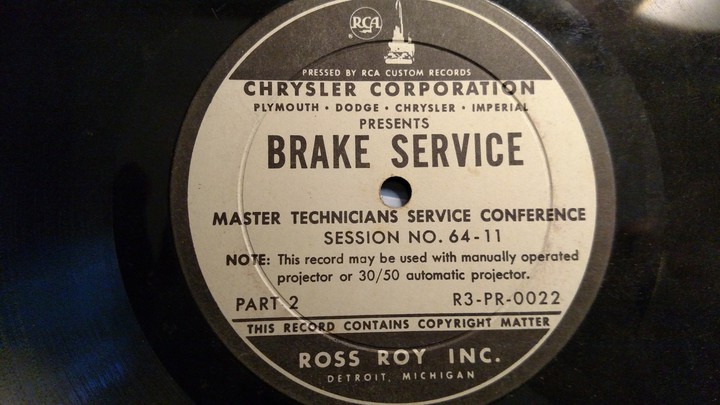You should upgrade or use an alternative browser.
- Thread starter DIM
- Start date
dr sportster
Well-known Member
old
Well-known Member
- Location
- Camdenton Missouri
dr sportster
Well-known Member
wilson ind
Well-known Member
old
Well-known Member
- Location
- Camdenton Missouri
As for the goats already found one dead and have not found any of the other 3.
Andy Martin
Well-known Member
I went out and looked at a 48 Suburban and 53 sedan. Suburban looks level, and the sedan looks like the master cylinder is lower. But I don't believe the elevation makes any difference. Brakes are a closed hydraulic system, if the wheel cylinder cups would hold pressure, they will hold air under a little vacuum. Try draining a wheel cylinder by unhooking the hose and sticking it in a cup of brake fluid. It won't drain. On the positive side, if the wheel cylinders are high it should make bleeding much simpler. You don't have to force the air down hill, you just have to encourage it to go up.(quoted from post at 14:51:31 01/01/16) Now OLD if you think about the old chev the master cylinder was just a little above the wheel. Not much but a little. Hope this finds you finding your goats alive and things looking up.
dr sportster
Well-known Member
Andy Martin
Well-known Member
I'm always surprised when Guido is right!(quoted from post at 16:13:38 01/01/16) Hello DIM,
Old style drum and shoe brakes have a residual presure of 7#. Location of the master cylinder does not matter!
Guido.
dr sportster
Well-known Member
Janicholson
Well-known Member
rustred
Well-known Member
T in NE
Well-known Member
- Location
- Cambridge, Nebraska
rustred
Well-known Member
dr sportster
Well-known Member
dr sportster
Well-known Member
rustred
Well-known Member
dr sportster
Well-known Member
guido
Well-known Member
The answer to his question Is a resounding NO! A have some questions for you though.
1: Do you know what a residual pressure valve is.?
2: Do you know what is its purpose.?
3: Where is it located.?
4: Is it even part of the braking system.?
Most importantly: could you answer all the above questions on a multiple question test?
Guido.
rustred
Well-known Member
i just told you what the residual valve is. and the system will not work properly if the master is lower than the wheel cyl's. because the fluid will be draining back to the master.
so whats your best answer here? besides a big NO! where is the facts?
and it would be nice to know what vehicle DIM is working on.
dr sportster
Well-known Member
(quoted from post at 20:23:49 01/01/16) Hello rustred,
The answer to his question Is a resounding NO! A have some questions for you though.
1: Do you know what a residual pressure valve is.?
2: Do you know what is its purpose.?
3: Where is it located.?
4: Is it even part of the braking system.?
Most importantly: could you answer all the above questions on a multiple question test?
Guido.
I know the answers to all of those.
Can I play?
Richard G.
Well-known Member
Old had it correct in the beginning of this thread.
Richard in NW SC
guido
Well-known Member
I did some digging of my own. If you look close you will see two numbers. 64 and 11. First number is the year, second number is the month. That is what I was doing November 1964. They call us technicians even then. Up to 1965 , that is the year I left the dealership, I did 90% of all brake work,
Guido.

Andy Martin
Well-known Member
Not arguing, I just don't understand how brake fluid could drain downhill into a master cylinder unless there was an air leak or air in the brake fluid. Vapor pressure of brake fluid has got to be pretty high, it wouldn't break into a vapor until well over 30 ft of elevation change.(quoted from post at 19:46:45 01/01/16) the lines being higher than the master cyl. is part of the problem. lines connect to btm of master and never are looped higher than the cyl.the master cyl. fluid compartment is the highest point in the brake system. the fluid is draining back into the master which causes you to pump the brakes to get the fluid back to brakes. that is where the residual valve comes in ... to stop this and keep a bit of pressure on the line.
Andy Martin
Well-known Member
(quoted from post at 18:17:05 01/01/16) Hello Andy Martin,
Anecdotal vs factual. Got to love it!
Guido
Similar threads
- Replies
- 1
- Views
- 441
We sell tractor parts! We have the parts you need to repair your tractor - the right parts. Our low prices and years of research make us your best choice when you need parts. Shop Online Today.
Copyright © 1997-2024 Yesterday's Tractor Co.
All Rights Reserved. Reproduction of any part of this website, including design and content, without written permission is strictly prohibited. Trade Marks and Trade Names contained and used in this Website are those of others, and are used in this Website in a descriptive sense to refer to the products of others. Use of this Web site constitutes acceptance of our User Agreement and Privacy Policy TRADEMARK DISCLAIMER: Tradenames and Trademarks referred to within Yesterday's Tractor Co. products and within the Yesterday's Tractor Co. websites are the property of their respective trademark holders. None of these trademark holders are affiliated with Yesterday's Tractor Co., our products, or our website nor are we sponsored by them. John Deere and its logos are the registered trademarks of the John Deere Corporation. Agco, Agco Allis, White, Massey Ferguson and their logos are the registered trademarks of AGCO Corporation. Case, Case-IH, Farmall, International Harvester, New Holland and their logos are registered trademarks of CNH Global N.V.
Yesterday's Tractors - Antique Tractor Headquarters
Website Accessibility Policy

